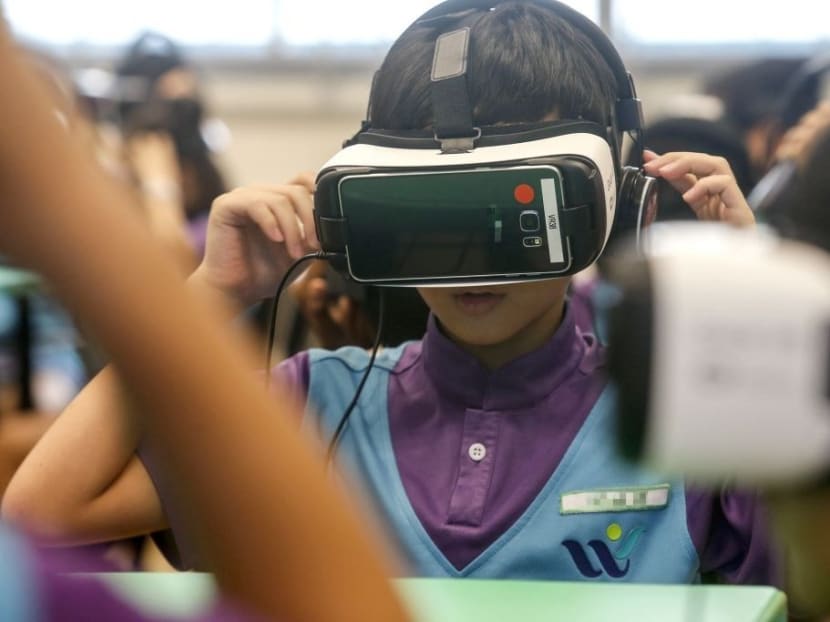M1 partners Huawei in 5G trial to stream live virtual reality content
SINGAPORE — The targeted roll out of the 5G network in Singapore by 2020 is picking up pace, with M1 and Chinese tech giant Huawei announcing on Thursday (June 21) that they will be conducting a live demonstration of a 360-degree virtual reality (VR) content broadcast by the end of the month.

The targeted roll out of the 5G network in Singapore by 2020 is picking up pace. M1 and Chinese tech giant Huawei announced on Thursday that they will be conducting a live demonstration of a 360-degree virtual reality (VR) content broadcast by the end of June, 2018.
SINGAPORE — The targeted roll out of the 5G network in Singapore by 2020 is picking up pace, with M1 and Chinese tech giant Huawei announcing on Thursday (June 21) that they will be conducting a live demonstration of a 360-degree virtual reality (VR) content broadcast by the end of the month.
The demonstration comes on the back of earlier trials conducted by rival telcos Singtel and StarHub in preparation of the 5G rollout.
In 2016, Singtel, in partnership with Ericsson, conducted live video streaming over 5G network at a high-frequency band. In the same year, StarHub also achieved a mobile broadband download speed of 4.3 Gigabits per second and latency of 1 millisecond after 5G trials with Nokia.
For their upcoming trial, M1 and Huawei noted that in recent years, “creative content and exciting new applications” have been developed using immersive technologies including VR, augmented reality (AR) and mixed reality (MR).
“These content and applications are extremely bandwidth-intensive and delay-sensitive, making them costly and technically challenging to stream or broadcast to a large number of users over existing cellular networks,” the two firms added.
While 5G mobile devices are currently not commercially available in Singapore, M1 will be using Huawei’s prototype 5G equipment setup at the telco’s MiWorld building in Jurong.
The demonstration will be conducted on the 28GHz millimetre wave frequency band, which has the capacity to accommodate a range of high data rate applications.
M1 chief technical officer Denis Seek said the live demo is a “small but significant step in our journey towards next generation 5G mobile networks”.
The difference between 5G — or the fifth-generation wireless network — and the current 4G technology is that the former could be faster, connect to more devices simultaneously and be more efficient at carrying heavy data content.
Among other things, a 5G network will enable users to download a feature-length movie within seconds, or allow students to go on a virtual learning journey while sitting at their desks in school.
“In the future smart classroom, for example, teachers could use the 5G network to share a 360-view AR, VR or MR videos to a classroom of students,” M1 and Huawei said. “This will capture their curiosity and imagination, aid information assimilation and retention, as well as make learning more interactive and interesting.”
Last year, the Info-communications Media Development Authority (IMDA) of Singapore also waived frequency fees for 5G trials, in a bid to spur the development of the technology.
DBS Group Research analyst Sachin Mittal said that a unique benefit of 5G was its low latency.
Latency, which refers to responsiveness, is the time it takes for data to travel between its source and destination. For example, it is the amount of time which a webpage takes to display results after a user keys in a website URL, said Mr Mittal.
With mobile speeds already at “satisfactory levels” among consumers here, Mr Mittal noted that the 5G deployment will initially be more beneficial for industry application.
“Latency is more critical in life and death situations, for example when you’re talking about healthcare. For instance, in an emergency case, if a surgeon had to operate remotely, and another doctor is advising and giving instructions, in these scenarios, there must be no delays,” said Mr Mittal.
Responding to queries, StarHub chief technology officer Chong Siew Loong said the telco is currently “working to install live 5G base stations to facilitate real-world tests”.
Globally, Huawei had conducted trials in 2016 with telcos in Japan, Australia and Germany. It found that latency was reduced to one millisecond with 5G, as compared to 20 to 40 milliseconds with 4G.
According to Huawei’s findings, 4G’s latency is too slow in allowing autonomous vehicles to communicate with each other.






